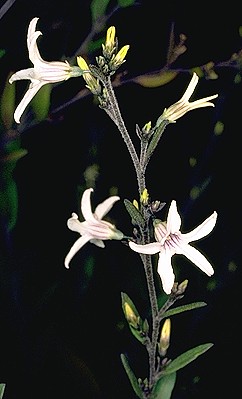 Photo: M. Fagg © ANBG |
 Photo: M. Fagg © ANBG |
 Line drawing by M. Perkins (from L.Haegi, unpubl. thesis). |
 Illustration by G. Dashorst, Fl. S. Aus. 3, f. 561 partly (1986). |

Synonymy
Cyphanthera anthocercidea (F. Muell.) Haegi, Telopea 2: 176 (1981)
Eadesia anthocercidea F. Muell., Trans. & Proc. Philos. Inst. Victoria 2: 72 (1858); Anthocercis eadesii F. Muell., Fragm. Phytogr. Austral. 2: 139 (1861), nom. illeg.; Anthocercis anthocercidea (F. Muell.) Druce, Bot. Soc. Exch. Club Brit. Isles Rep. 1916, Suppl. 2: 605 (1917).
T: Near Mt Zero, Vic., C. Wilhelmi s.n.; syn: K, MEL.
[Anthocercis frondosa auct. non (Meiers) Black, e.g. J.H. Willis, Handbook Pl. Victoria 2: 558 (1972).]
[Anthocercis genistifolia Gand., Bull. Soc. Bot. France 65: 69 (1918).]
Description
Erect shrub to 2 m. Branches moderately tomentose with both dendritic, non-glandular hairs and smaller glandular hairs.
Leaves ovate to narrowly ovate, rarely ovate-elliptic, sessile or almost so, 8–35 mm long, 2–10 mm wide, sparsely pubescent; juvenile leaves up to 11 cm long and 4 cm wide, with petioles to 15 mm long.
Inflorescence panicle-like, dense, leafy; pedicels 2.5–6.5 mm long, sparsely pubescent. Calyx 3–4 mm long, glabrous or almost so. Corolla 10–14.5 mm long, almost glabrous, white, the striations purple; lobes ovate-truncate to linear, 4–5.5 (rarely 9) mm long. Stamens 2–4 mm long.
Capsule more or less globose, 4–5 mm diam. Seeds 2.4–3.5 mm long.
Distribution and ecology
Occurs mainly in the Wimmera region of Vic.; recorded from eastern Vic. but not collected there since 1882.
Occurs in rocky gullies in dry, sclerophyll forest, and on exposed rocky spurs in shrubland, in sandy soils derived from sandstone.
Notes
Phylogeny
Phylogenetic studies by Garcia & Olmstead (2003) on the Tribe Anthocercideae using two chloroplast DNA regions included this species The studies indicated that Cyphanthera is not monophyletic. Cyphanthers odgersii showed a closer relationship to Grammosolen while the rest of the Cyphanthera species combined to form a clade with Duboisia and Crenidium.
Reference: V.F.Garcia & R.G.Olmstead (2003). Phylogenetics of Tribe Anthocercideaea (Solanaceae) based on ndhF and trnL/F sequence data. Systematic Botany 28: 609-615.
Selected specimens
Vic.: c. 1.5 km E of Mt Zero, L. Haegi 1450 (AD, BIRM, CORD, F, MEL, MO, NSW, PERTH); north Grampians, R. Hill 1195 (AD); near Mt Zero, M.E. Phillips 206 (MEL).
Derivation of epithet
Presumably a reference to a resemblance to the genus Anthocercis.
Images and information on web
An image of C. anthocercidea can be seen on the Canberra Botanic Gardens site at http://www.anbg.gov.au/images/photo_cd/J01112585F5/038.html
Pharmacology: A discussion of the tropane alkaloids which occur in Cyphanthera and other Anthocercideae can be found in Griffith & Lin (2000).
Ref: W.J. Griffin & G.D. Lin (2000). Chemotaxonomy and geographical distribution of tropane alkaloids. Phytochemistry 53: 627–628.
Plant status (if any)
Classified as Risk Code 2RCa (Briggs & Leigh, Rare or Threatened Australian Plants, 1995).